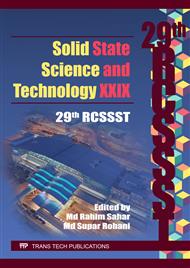[1]
R. Arun Kumar, Borate crystals for nonlinear optical and laser applications: A review, J. Chem., p.1–7, (2013).
Google Scholar
[2]
D. Thomazini, F. Lanciotti Jr., and A. S. B. Sombra, Structural properties of lithium borate glasses doped with rare earth ions, Cerâmica, vol. 47, no. 302, p.88–93, (2001).
DOI: 10.1590/s0366-69132001000200005
Google Scholar
[3]
A. Bhogi, R. Vijaya Kumar, and P. Kistaiah, Effect of alkaline earths on spectroscopic and structural properties of Cu2+ ions-doped lithium borate glasses, J. Non. Cryst. Solids, vol. 426, p.47–54, (2015).
DOI: 10.1016/j.jnoncrysol.2015.06.012
Google Scholar
[4]
Wang Zhongcai et. al, The network structure of niobium borate glasses, J. Non. Cryst. Solids, vol. 80, p.160–166, (1986).
DOI: 10.1016/0022-3093(86)90390-x
Google Scholar
[5]
R. Sonam, S. Sujata, A. Ashish, and K. Satish, Influence of Nb2O5 on the optical band gap and electrical conductivity of Nb2O5 ·BaO·B2O3, IOP Conf. Ser. Mater. Sci. Eng., vol. 2, no. 1, p.12041, (2009).
Google Scholar
[6]
S. Sanghi, A. Sheoran, A. Agarwal, and S. Khasa, Conductivity and dielectric relaxation in niobium alkali borate glasses, Phys. B Condens. Matter, vol. 405, no. 24, p.4919–4924, (2010).
DOI: 10.1016/j.physb.2010.09.032
Google Scholar
[7]
R. Arun Kumar, M. Arivanandhan, and Y. Hayakawa, Recent advances in rare earth-based borate single crystals: Potential materials for nonlinear optical and laser applications, Prog. Cryst. Growth Charact. Mater., vol. 59, no. 3, p.113–132, (2013).
DOI: 10.1016/j.pcrysgrow.2013.07.001
Google Scholar
[8]
K. Semwal and S. C. Bhatt, Study of Nd3+ ion as a Dopant in YAG and Glass Laser, Int. J. Phys., vol. 1, no. 1, p.15–21, (2013).
Google Scholar
[9]
A. R. Devi and C. K. Jayasankar, Optical properties of Nd3+ ions in lithium borate glasses, Mater. Chem. Phys., vol. 42, no. 2, p.106–119, (1995).
DOI: 10.1016/0254-0584(95)01564-7
Google Scholar
[10]
D. D. Ramteke, K. Annapurna, V. K. Deshpande, and R. S. Gedam, Effect of Nd3+ on spectroscopic properties of lithium borate glasses, J. Rare Earths, vol. 32, no. 12, p.1148–1153, (2014).
DOI: 10.1016/s1002-0721(14)60196-4
Google Scholar
[11]
Y. C. Ratnakaram, A. Vijaya Kumar, D. Tirupathi Naidu, and R. P. S. Chakradhar, Absorption and emission properties of Nd3+ in lithium cesium mixed alkali borate glasses, Solid State Commun., vol. 136, no. 1, p.45–50, (2005).
DOI: 10.1016/j.ssc.2005.06.016
Google Scholar
[12]
S. Wu, J. Lian, P. Song, S. Gao, X. Wang, W. Guan, Z. Ma, and Y. Wang, Study on the Optical Properties of Lithium Borate Glass Doped with Nd3+, 2011 Symp. Photonics Optoelectron., p.1–3, (2011).
DOI: 10.1109/sopo.2011.5780650
Google Scholar
[13]
W. H. A. Kamaruddin, M. S. Rohani, M. R. Sahar, H. LIU, and Y. SANG, Synthesis and characterization of lithium niobium borate glasses containing neodymium, J. Rare Earths, vol. 34, no. 12, p.1199–1205, (2016).
DOI: 10.1016/s1002-0721(16)60154-0
Google Scholar
[14]
F. Steudel, A. C. Rimbach, S. Loos, B. Ahrens, and S. Schweizer, Effect of induced crystallization in rare-earth doped lithium borate glass, Radiat. Meas., vol. 90, p.274–278, (2016).
DOI: 10.1016/j.radmeas.2015.12.046
Google Scholar
[15]
B. Bhatia, S. Singh, and A. S. Verma, Spectroscopic Properties of Pr3+ in Lithium Bismuth Borate Glasses, Am. J. Condens. Matter Phys., vol. 3, no. 3, p.80–88, (2013).
Google Scholar
[16]
Y. C. Ratnakaram, A. Vijaya kumar, D. T. Naidu, R. P. S. Chakradhar, and K. P. Ramesh, Optical absorption and luminescence properties of Nd3+ in mixed alkali borate glasses—Spectroscopic investigations, J. Lumin., vol. 110, no. 1–2, p.65–77, (2004).
DOI: 10.1016/j.jlumin.2004.04.004
Google Scholar


